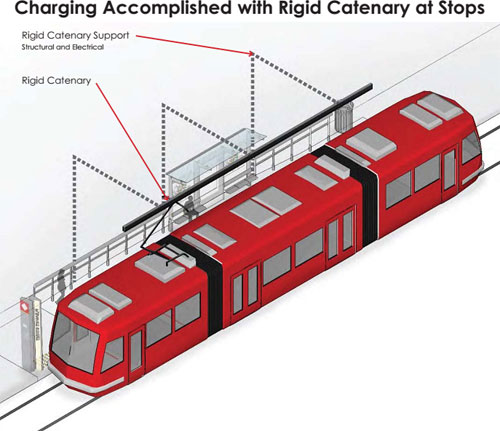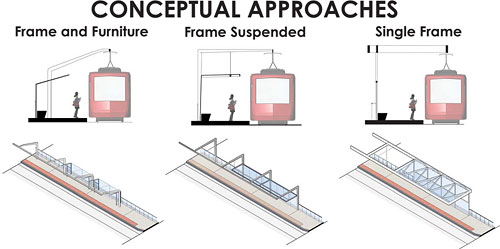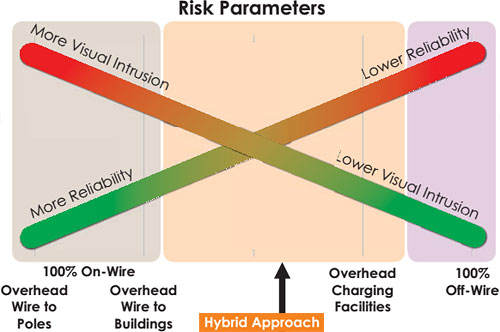West of Union Station, no overhead streetcar wires
When (and if) DC extends the streetcar from Union Station to Georgetown, it almost certainly won’t use overhead wires, except at stations. Connections in the stations’ canopies will charge supercapacitors for power, according to the latest plans.
This is part of the information the District Department of Transportation (DDOT) will present at a meeting Tuesday night and which we got an exclusive early look at. Earlier, we talked about how using almost entirely dedicated lanes was a new (and better) option.
DDOT has also been studying power systems. Wires were banned in the part of DC originally designed by Pierre L’Enfant during the old streetcar days, so streetcars used “plows” that ran in grooves in the ground. These systems were very failure-prone, and modern technology can do better.
On H Street, the streetcars now use overhead wires, a tried-and-true (and not so ugly as all that) power system. However, federal planners and local preservationists have opposed wires on major “viewsheds” and, if the streetcar ever crosses the National Mall, there as well.
A possible solution is a hybrid system, where the streetcar connects to wires in some places but runs on batteries elsewhere. Jamie Henson, who’s in charge of the Union Station to Georgetown study, and his team at DDOT believe that the technology is fast reaching the point where the wires only need to be at the stations themselves.
Under the plan DDOT is currently studying, the “wires” would be “rigid catenary” that look like they’re part of a station canopy. When a streetcar pulls into a station, its pantographs would contact these canopy elements and start drawing power.
How the power would work
Charging batteries is slow, but supercapacitors can charge very fast. The streetcar could charge the supercapacitors in 20-30 seconds, Henson said, which can include some of the time the streetcar is finishing pulling in or starting to pull out. The supercapacitors then would more slowly discharge into the batteries.
The vehicles would also use regenerative braking, which charges the batteries when a vehicle brakes. There could also be wires where the streetcar line is underneath a roadway like the Whitehurst Freeway or Washington Circle.
According to an analysis by the project team, this would generate enough energy to power the streetcars even when heavily loaded, on a very hot or cold day with heat or air conditioning at full blast.
While this is the leading edge of streetcar technology, said Henson, other cities such as Dallas have hybrid off-wire segments and there are proposals for hybrid systems in Detroit, Oklahoma City, and Milwaukee. Henson said streetcar technology is building on bus technology, which is slightly farther ahead.
DC is still 3-4 years away from the point of actually ordering more streetcars. Henson said he believes it is “reasonable to expect” the technology would be developed to a sufficient level by that time.
I hope so. Making this project depend on as-yet-unproven technology seems risky. While some people have long been fighting overhead wires, many far more historic European cities have trams with wires and it doesn’t destroy their beauty.
It was clear that federal interests wouldn’t allow wires across viewsheds (rightly or wrongly), but DDOT could accommodate that with shorter gaps in wires. That puts a lot less demand on a vehicle’s batteries and thus demands less of a technological leap. If the tech works, that’d be great, but what if not?
What about the current line?
Hybrid vehicles could use the current wires on H Street/Benning Road and the future eastward extension to Benning Metro (assuming that extension ends up using wires, which is still an open question).
The existing streetcar vehicles wouldn’t work on the hybrid line. According to Henson, part of the upcoming work in the Union Station to Georgetown study will include analyzing whether to have some vehicles only run east of Union Station, retrofit them to use hybrid technology, or replace them entirely.
However, this was going to be necessary regardless — full wires to Georgetown was never in the cards. The team seems to have a promising approach, but will have to be very vigilant to ensure that DC takes advantage of current technology, maximizing the benefit, while also guarding against buying cars that turn out to be lemons or investing in technology that leaves the cars stranded.
But if DC chooses dedicated lanes for the extension, that has a big benefit for the wireless technology: Not having to worry about traffic congestion makes it easier to go off-wire, knowing the batteries don’t have to have enough power for very long stints in traffic.
Ask for dedicated lanes using the form below.
Read more from today’s streetcar mega-feature:
- Now that it’s open, 7 takeaways from the H Street streetcar
- DC’s streetcar may go to Georgetown with dedicated lanes
- West of Union Station, no overhead streetcar wires
- A loop ramp under K Street and a pedestrian walkway
- Before going to Georgetown, the streetcar will go east to Benning Road




